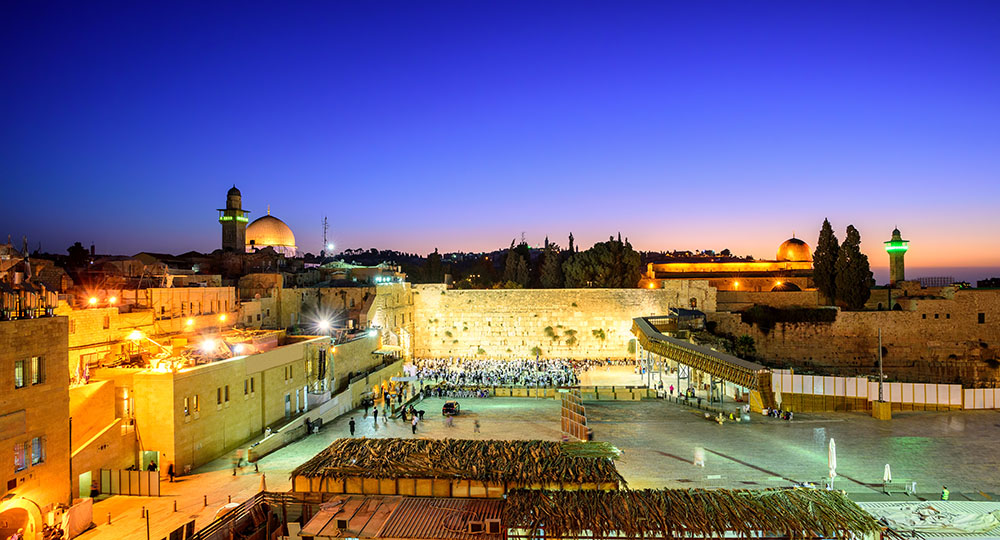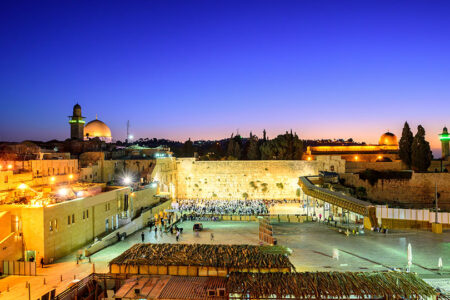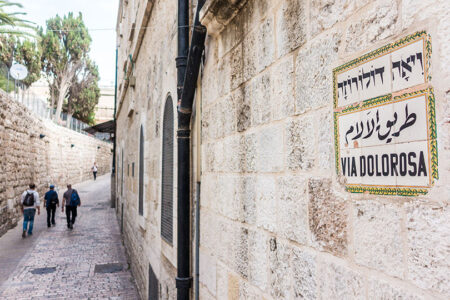Jerusalem of Gold
Welcome to the only city in the world where God has chosen to place His name!
If you’ve never been to Jerusalem, it’s time you made the trip. But if you can’t go in person, I suggest you relax, put your feet up, and come with me on an imaginary tour of the city of the great King.
The psalmist wrote, “If I forget you, O Jerusalem, let my right hand forget its skill! If I do not remember you, let my tongue cling to the roof of my mouth—if I do not exalt Jerusalem above my chief joy” (Ps. 137:5–6). Over the last three millennia, God has never revoked His declaration: “I have chosen Jerusalem, that My name may be there” (2 Chr. 6:6). So, let’s go exploring.
The Tunnel and Pool
The Old City is built on two north-to-south ridges of the Judean hills. Its stone wall, about two and a half miles in circumference, encircles and defines the city’s perimeter. The stones date from several periods. Some on the eastern side go all the way back to the First-Temple era.
At the beginning of the Davidic kingdom, Jerusalem occupied the southern and lower part of the eastern ridge. King Solomon expanded the city northward to include the top of the eastern ridge, Mount Moriah, where he built the first Temple (3:1).
Approximately 250 years later, to protect his growing population from the threatening Assyrians, King Hezekiah built a massive stone wall 27 feet high and 23 feet wide that incorporated the western ridge of modern-day Jerusalem for the first time (32:5). A portion of this “Broad Wall” still exists.
Hezekiah also brought the waters of the Gihon Spring inside the city walls through an underground tunnel 1,750 feet long (v. 30). Water still runs through it today, sometimes over your knees. As we walk along, we can see a facsimile of a Hebrew inscription written on the tunnel wall by one of Hezekiah’s workmen commemorating the completion of the aqueduct.
A 16-year-old Jewish boy, Jacob Eliahu, a believer in Jesus, discovered the original inscription while exploring the tunnel in 1880.1 Three years later, the boy was formally adopted into the family of Horatio G. Spafford, who wrote the beloved hymn “It Is Well With My Soul.” Spafford and his wife lived with their family in Jerusalem for years and started what became known as the American Colony. They are buried in the city’s Mount Zion Cemetery.
About 300 feet south of Hezekiah’s Tunnel lies the biblical Pool of Siloam, where Jesus sent a man blind from birth to wash in order to receive his sight (Jn. 9:7). Only half of this 225-foot-long swimming pool discovered in 2004 has been excavated, but the Israel Antiquities Authority and National Parks Authority recently announced plans to begin further excavation.
We can visualize the blind man painstakingly making his way into the water and emerging able to see the world for the first time. As we sit on the steps pondering this miracle, we rejoice knowing that Jesus not only healed the blind then but that He also heals the spiritually blind today who go to Him for cleansing.
The Temple Mount Area
From the Pool of Siloam we walk to the Temple Mount area. From AD 30 to 70, we would have walked north with Jewish pilgrims on an amazing, paved street consisting of 10,000 tons of carved stone. It was roughly 26 feet wide, over a third of a mile long, and gained 223 feet in elevation as worshipers ascended its steps.
Unfortunately, we can’t take Pilgrimage Road, as it is called today. It is being excavated with hopes of opening it soon to the public. We can, however, travel underneath Pilgrimage Road via a drainage tunnel that dates back to the Second-Temple period. Archaeologists have cleared it so adventurous tourists can walk through it, taking the same northern route the ancient pilgrims used, only beneath the street instead of on it.
At the end of our subterranean trek, we leave our claustrophobia behind and ascend a metal, spiral staircase that opens into daylight at the southwestern section of the retaining wall that surrounds the Temple Mount complex.
To the left sits a pile of enormous stones, a silent witness to Roman demolition, having been tossed from high above onto the Pilgrimage Road below. Although these stones were not part of the Temple buildings themselves, they remind us of Jesus’ prophecy: “Do you see these great buildings? Not one stone shall be left upon another, that shall not be thrown down” (Mk. 13:2).
On the wall’s southern side are the remains of the original stairs most worshipers climbed to enter the Temple’s southern gates. Jesus Himself undoubtedly walked these stairs at some point. When tourists to Israel want to “walk where Jesus walked,” they can come to this staircase and fulfill their wishes.
From the southern wall, we go to the famous Western Wall. Thousands of Jewish and non-Jewish people visit this retaining wall and its plaza every year. Because it was the closest wall to the holy of holies, this exposed section has become the holiest spot on Earth for the Jewish people. They come from around the world to hold celebrations here and place written prayers between the ancient stones.
Above the wall is the Temple Mount. In 1967, Israel gave the Muslim authorities guardianship over the Temple Mount, once dominated by Solomon’s Temple (374 years), then the Second Temple (585 years), and now by the gold-domed Muslim Dome of the Rock. Other Muslim structures are also on the Mount. The Dome of the Rock sits where many believe Abraham offered Isaac and where the Ark of the Covenant sat in Solomon’s Temple.
At the beginning of the Second-Temple period, the sacred area of the Temple Mount formed a 500-cubit square (741,321 square feet).2 The Court of the Gentiles on the south side is where non-Jews were welcomed. However, twice Jesus drove out money changers from this area, along with people selling sacrificial animals, saying they made His Father’s house a “den of thieves” (Mt. 21:12–13).
To the right, along the entire eastern wall, would have been a colonnade known as Solomon’s Porch. It was there, during Hanukkah, that Jesus proclaimed He and the Father were one (Jn. 10:22–23, 30).
To the north would have been a stone partition five feet high with Greek and Latin inscriptions warning Gentiles that if they ventured beyond this point, they would have no one to blame for their deaths but themselves. The apostle Paul had this partition in mind when he wrote that Jesus broke down the “middle wall of separation” between Jew and Gentile so that “through Him we both have access by one Spirit to the Father” (Eph. 2:14, 18).
First-century Israelites could go beyond the warning signs and enter the Temple Court of the Women, otherwise known as the Treasury, through a gate on the east. This is where Mary and Joseph presented Jesus as an infant to the Lord (Lk. 2:22) and where Jesus did much of His teaching as an adult. Nowadays, if we stood at the foot of a flight of stairs 215 feet east of the Dome of the Rock, we would be at the center of the original Court of the Women.
If we went up that flight of stairs, we would be where the impressive Nicanor Gate stood—two large, bronze doors that separated the Court of the Women from the Court of the Israelites (males only). Beyond those doors was as far as a nonpriest could go.
Going 75 feet farther west on our imaginary tour, and a little to the left, would take us to the immense bronze altar, the place of burnt offerings. Proceeding slightly more west, to today’s Muslim Dome of the Chain, would bring us to what was the porch of Herod’s Temple.
If we were able to go into the Dome of the Rock, which is not permitted for non-Muslims, many believe we would be standing in the Temple’s holy of holies in Jesus’ day.
It’s awe-inspiring to think of all the biblical events that transpired on this mountaintop and that, someday, another Temple will stand on the Temple Mount; and the God of Israel will dwell within it:
Then I heard Him speaking to me from the temple. . . . And He said to me, “Son of man, this is the place of My throne and the place of the soles of My feet, where I will dwell in the midst of the children of Israel forever” (Ezek. 43:6–7).
As we look eastward, the Mount of Olives rises before us. Covered with the graves of Jewish people who hoped for the coming of the Messiah, it reminds us that, one day, our Savior will return. Jesus, Israel’s Messiah, the King of glory, will make His way through the eastern gate of the Millennial Temple that will be built on this very mountain. He will take His seat on the throne of David and reign forever over the whole earth (Ps. 24:7–10; Ezek. 43:1–7; Lk. 1:31–33).
Until that day, we must pray for the peace of Jerusalem. “May they prosper who love you” (Ps. 122:6).
ENDNOTES
-
- Bertha Spafford Vester, Our Jerusalem: An American Family in the Holy City, 1881-1949 (Garden City, NY: Doubleday & Company, 1950), 90–92.
- Leen and Kathleen Ritmeyer, Jerusalem: The Temple Mount (Jerusalem, Israel: CartaJerusalem, 2015), 75.
Photo: Adobe Stock









Well researched document in physical sites themselves! Keep it Up.